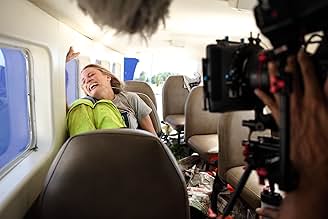Eine Gruppe studentischer Aktivisten reist in das Amazonasgebiet, um den Regenwald zu retten, und stellt dabei schnell fest, dass sie nicht alleine sind und dass keine gute Tat ungestraft bl... Alles lesenEine Gruppe studentischer Aktivisten reist in das Amazonasgebiet, um den Regenwald zu retten, und stellt dabei schnell fest, dass sie nicht alleine sind und dass keine gute Tat ungestraft bleibt.Eine Gruppe studentischer Aktivisten reist in das Amazonasgebiet, um den Regenwald zu retten, und stellt dabei schnell fest, dass sie nicht alleine sind und dass keine gute Tat ungestraft bleibt.
- Auszeichnungen
- 1 Gewinn & 6 Nominierungen insgesamt
Clara Vázquez
- Elder's Assistant
- (as Clara Vazquez)
Handlung
WUSSTEST DU SCHON:
- WissenswertesWhen Eli Roth and his crew approached villagers to be extras in the film, he soon realized that they had never seen a movie and had no concept of what one was. To demonstrate what a movie was, Eli brought a TV and a copy of Nackt und zerfleischt (1980) and had a screening for everyone. The villagers loved it and thought it was a comedy. They gladly acted in the film.
- PatzerAs Kara is walking away after helping Justine chain herself to a tree, her face mask is on her arm; seconds later it's hanging on her neck and she is proceeding to put it on. All the while Justine is calling her name because her lock isn't working, then Justine appears struggling, then back to Kara getting her cell phone out of her pocket, but the mask seems to have disappeared, then it goes back to Justine, again still struggling with her lock, then back to Kara holding her cell phone up and magically her mask is back on her face. All this in a matter of seconds.
- Crazy CreditsAfter the song credits and before the special thanks, there is a "brief history of the Italian cannibal genre and their many names, along with their directors and their many names".
- Alternative VersionenIn Singapore, the film was edited before it could be approved for release with an R21 rating. The distributor was made to remove an instance of strong graphic violence which the board felt was gratuitous; the scene in question occurs as the natives hold a man down and torture him cracking open his skull, removing his tongue and limbs, gouging his eyes out and severing his limbs. Without these cuts the film would have been refused classification.
- VerbindungenFeatured in The Tonight Show with Jay Leno: Folge #22.24 (2013)
- SoundtracksJanitors
Performed by Ariel Levy Dor
Written by Ariel Levy Dor
Courtesy of Ariel Levy Dor
Ausgewählte Rezension
Think about the first time you rode some big, new roller coaster. As you waited in line and contemplated what lay ahead, your heart started beating faster. When you occupied your seat, and the picture in front of you began to move, you found yourself wondering what you had gotten yourself into. As you arrived at that first really scary moment, you resisted the urge to close your eyes, even as others around you were enjoying the thrill by thrusting their arms into the air. From that point, everything was a blur of shouts and screams, ups and downs, punctuated by brief moments of relative stillness. Then, suddenly, the ride ended. You were surprised how quickly it went by and, even though you felt a little queasy, you were glad you had the experience. You even may have commented that it wasn't as bad as you thought it was going to be, and that you kind of enjoyed it, all as you started to look forward to that next uncomfortable challenge. You just rode a scary new coaster, but might as well have been experiencing the uncomfortable thrill of a new Eli Roth movie
one like "The Green Inferno" (R, 1:40), for example.
Personal feelings about graphically violent movies like the "Saw" franchise or Roth's own "Hostel" films aside, Roth's film "The Green Inferno" has a colorful history. The film traces its roots to cannibal-themed movies made in Italy during the 1970s and 80s. Roth's 2015 resurrection of this controversial horror sub-genre draws most directly from 1980's "Cannibal Holocaust", a movie so realistic that director Ruggero Deodato was arrested and put on trial for the murder of some of the actors in the film. (Deodato was only exonerated after he gathered all of his actors together for a TV show appearance and then demonstrated in court the special effects used to create the actors' "deaths".) That movie's working title was "The Green Inferno", a title which was eventually applied to the most gruesome scenes in "Cannibal Holocaust", specifically, the film within the film that purports to show footage from a missing documentary film crew. (This was the first use of the "found footage" or "pseudo-documentary" device, which was popularized in the U.S. by 1999's "The Blair Witch Project".) The title "The Green Inferno" was later also used as an alternate title for the 1988 sequel "Cannibal Holocaust II". Eli Roth filmed "The Green Inferno" in the jungles of Peru in 2012. His film opened at the 2013 Toronto International Film Festival. It was scheduled to be released in the U.S. in September 2014, but financial problems at the film's production company led to the film being pulled. Blumhouse Productions stepped in and the company's multi-platform releasing arm, BH Tilt, released "The Green Inferno" on September 25, 2015.
After a brief scene of bulldozers flattening a rain forest in the Amazon, the narrative of Roth's cannibal film starts innocuously on the streets of New York City. College freshman Justine (Lorenza Izzo) and her roommate, Kaycee (singer-songwriter Sky Ferreira), are annoyed by the student activists protesting outside their window, but Justine is also intrigued. She attends one of the group's meetings in which their charismatic student leader, Alejandro (Ariel Levy), discusses their plan to save a village in Peru from being overrun by bulldozers paving the way for a natural gas mining operation. The students plan to dress as workers, chain themselves to trees and bulldozers, then live stream video from their cell phones to get the world's attention – and keep themselves from being shot by the armed mercenaries which protect the operation. Justine's dad (Richard Burgi), a lawyer at the U.N., expresses his reservations, but Justine goes on what she naively believes will be a weekend trip to save a native tribe from extinction.
After landing in Peru, everything goes according to plan until their small plane crashes in the Amazonian jungle. Several of the students die in the crash, but the survivors are captured by the very tribe that the group was there to save. Not speaking any English or having had any positive experience with outsiders, the tribe considers their captives their enemy – and their dinner. One of the students is ritualistically killed by the village's elder / high priestess (Antonieta Pari) and then he is promptly dismembered, cooked and eaten. His friends watch in horror from behind the wooden bars where they are confined. What follows are more killings, more feasting and various attempts by the students to escape before the natives finish them off, whether for food, as punishment, or because of their brutal religious practices.
"The Green Inferno" is a wonderful family movie. (Still reading? Just checking.) Actually, the film is more restrained than I expected. There's much less nudity than in previous Eli Roth movies and the gore, as disturbing as it is, could have been a lot more graphic, given what's happening on screen. Most of what's shown is on par with typical slasher flicks. You might even say that this is a relatively tasteful cannibal movie. The story's solid, the acting's fairly decent for this genre and the film works as a horror movie, a thriller, a political commentary and there's even some dark comedy. Some call this kind of movie "torture porn". I think that's a stretch, but the more graphic scenes make it difficult to simply call this movie "entertaining" without qualifying the term. I judge movies based on how entertaining they are and how well they each accomplish their individual goals. Based on those measures, I'd have to say that, much like that big, new roller coaster, this movie isn't for everyone, but many will find it bloody good. "B+"
Personal feelings about graphically violent movies like the "Saw" franchise or Roth's own "Hostel" films aside, Roth's film "The Green Inferno" has a colorful history. The film traces its roots to cannibal-themed movies made in Italy during the 1970s and 80s. Roth's 2015 resurrection of this controversial horror sub-genre draws most directly from 1980's "Cannibal Holocaust", a movie so realistic that director Ruggero Deodato was arrested and put on trial for the murder of some of the actors in the film. (Deodato was only exonerated after he gathered all of his actors together for a TV show appearance and then demonstrated in court the special effects used to create the actors' "deaths".) That movie's working title was "The Green Inferno", a title which was eventually applied to the most gruesome scenes in "Cannibal Holocaust", specifically, the film within the film that purports to show footage from a missing documentary film crew. (This was the first use of the "found footage" or "pseudo-documentary" device, which was popularized in the U.S. by 1999's "The Blair Witch Project".) The title "The Green Inferno" was later also used as an alternate title for the 1988 sequel "Cannibal Holocaust II". Eli Roth filmed "The Green Inferno" in the jungles of Peru in 2012. His film opened at the 2013 Toronto International Film Festival. It was scheduled to be released in the U.S. in September 2014, but financial problems at the film's production company led to the film being pulled. Blumhouse Productions stepped in and the company's multi-platform releasing arm, BH Tilt, released "The Green Inferno" on September 25, 2015.
After a brief scene of bulldozers flattening a rain forest in the Amazon, the narrative of Roth's cannibal film starts innocuously on the streets of New York City. College freshman Justine (Lorenza Izzo) and her roommate, Kaycee (singer-songwriter Sky Ferreira), are annoyed by the student activists protesting outside their window, but Justine is also intrigued. She attends one of the group's meetings in which their charismatic student leader, Alejandro (Ariel Levy), discusses their plan to save a village in Peru from being overrun by bulldozers paving the way for a natural gas mining operation. The students plan to dress as workers, chain themselves to trees and bulldozers, then live stream video from their cell phones to get the world's attention – and keep themselves from being shot by the armed mercenaries which protect the operation. Justine's dad (Richard Burgi), a lawyer at the U.N., expresses his reservations, but Justine goes on what she naively believes will be a weekend trip to save a native tribe from extinction.
After landing in Peru, everything goes according to plan until their small plane crashes in the Amazonian jungle. Several of the students die in the crash, but the survivors are captured by the very tribe that the group was there to save. Not speaking any English or having had any positive experience with outsiders, the tribe considers their captives their enemy – and their dinner. One of the students is ritualistically killed by the village's elder / high priestess (Antonieta Pari) and then he is promptly dismembered, cooked and eaten. His friends watch in horror from behind the wooden bars where they are confined. What follows are more killings, more feasting and various attempts by the students to escape before the natives finish them off, whether for food, as punishment, or because of their brutal religious practices.
"The Green Inferno" is a wonderful family movie. (Still reading? Just checking.) Actually, the film is more restrained than I expected. There's much less nudity than in previous Eli Roth movies and the gore, as disturbing as it is, could have been a lot more graphic, given what's happening on screen. Most of what's shown is on par with typical slasher flicks. You might even say that this is a relatively tasteful cannibal movie. The story's solid, the acting's fairly decent for this genre and the film works as a horror movie, a thriller, a political commentary and there's even some dark comedy. Some call this kind of movie "torture porn". I think that's a stretch, but the more graphic scenes make it difficult to simply call this movie "entertaining" without qualifying the term. I judge movies based on how entertaining they are and how well they each accomplish their individual goals. Based on those measures, I'd have to say that, much like that big, new roller coaster, this movie isn't for everyone, but many will find it bloody good. "B+"
- CleveMan66
- 24. Sept. 2015
- Permalink
Top-Auswahl
Melde dich zum Bewerten an und greife auf die Watchlist für personalisierte Empfehlungen zu.
Details
- Erscheinungsdatum
- Herkunftsländer
- Offizielle Standorte
- Sprachen
- Auch bekannt als
- Caníbales
- Drehorte
- Produktionsfirmen
- Weitere beteiligte Unternehmen bei IMDbPro anzeigen
Box Office
- Budget
- 5.000.000 $ (geschätzt)
- Bruttoertrag in den USA und Kanada
- 7.192.291 $
- Eröffnungswochenende in den USA und in Kanada
- 3.520.626 $
- 27. Sept. 2015
- Weltweiter Bruttoertrag
- 12.666.449 $
- Laufzeit1 Stunde 40 Minuten
- Farbe
- Sound-Mix
- Seitenverhältnis
- 2.39 : 1
Zu dieser Seite beitragen
Bearbeitung vorschlagen oder fehlenden Inhalt hinzufügen





































